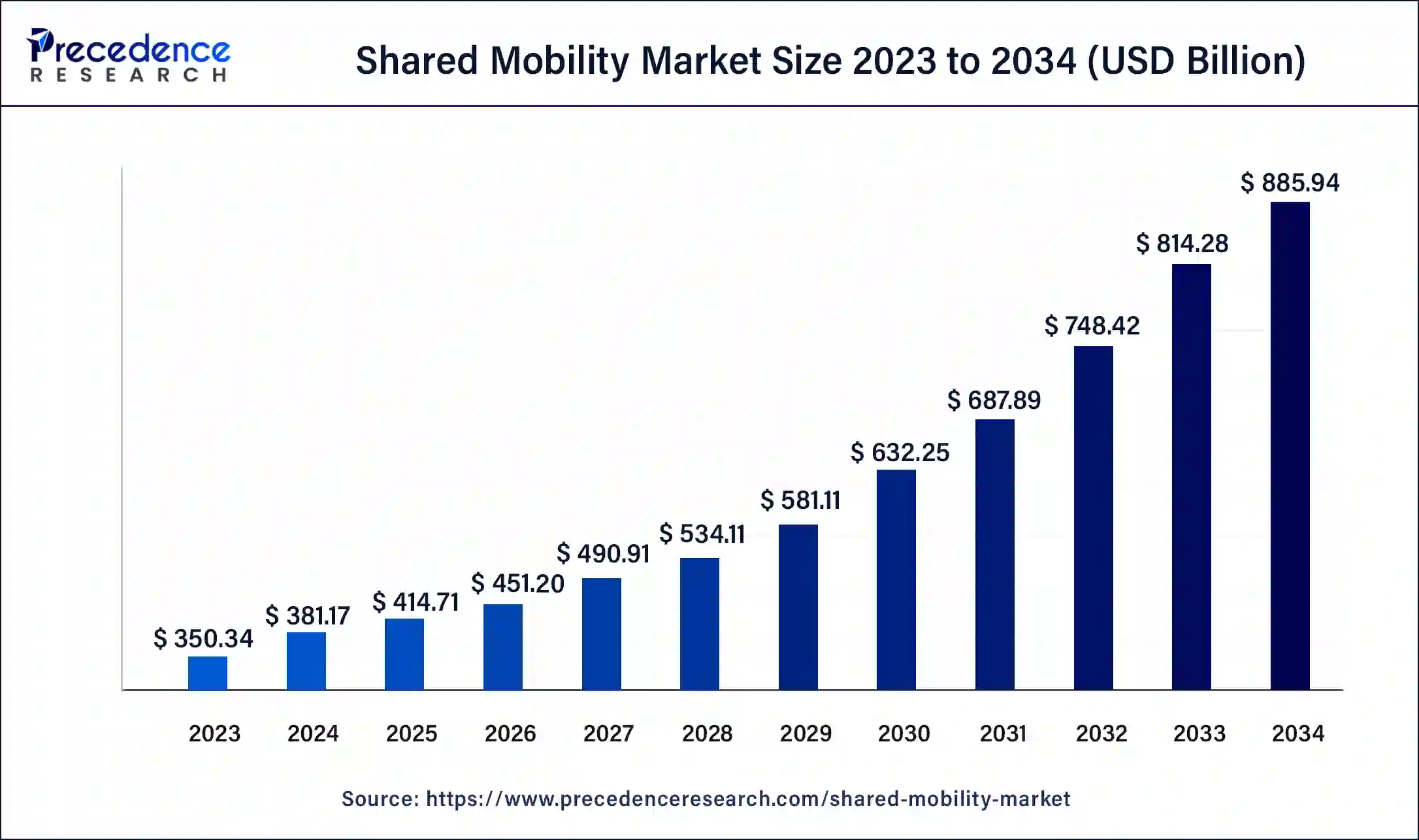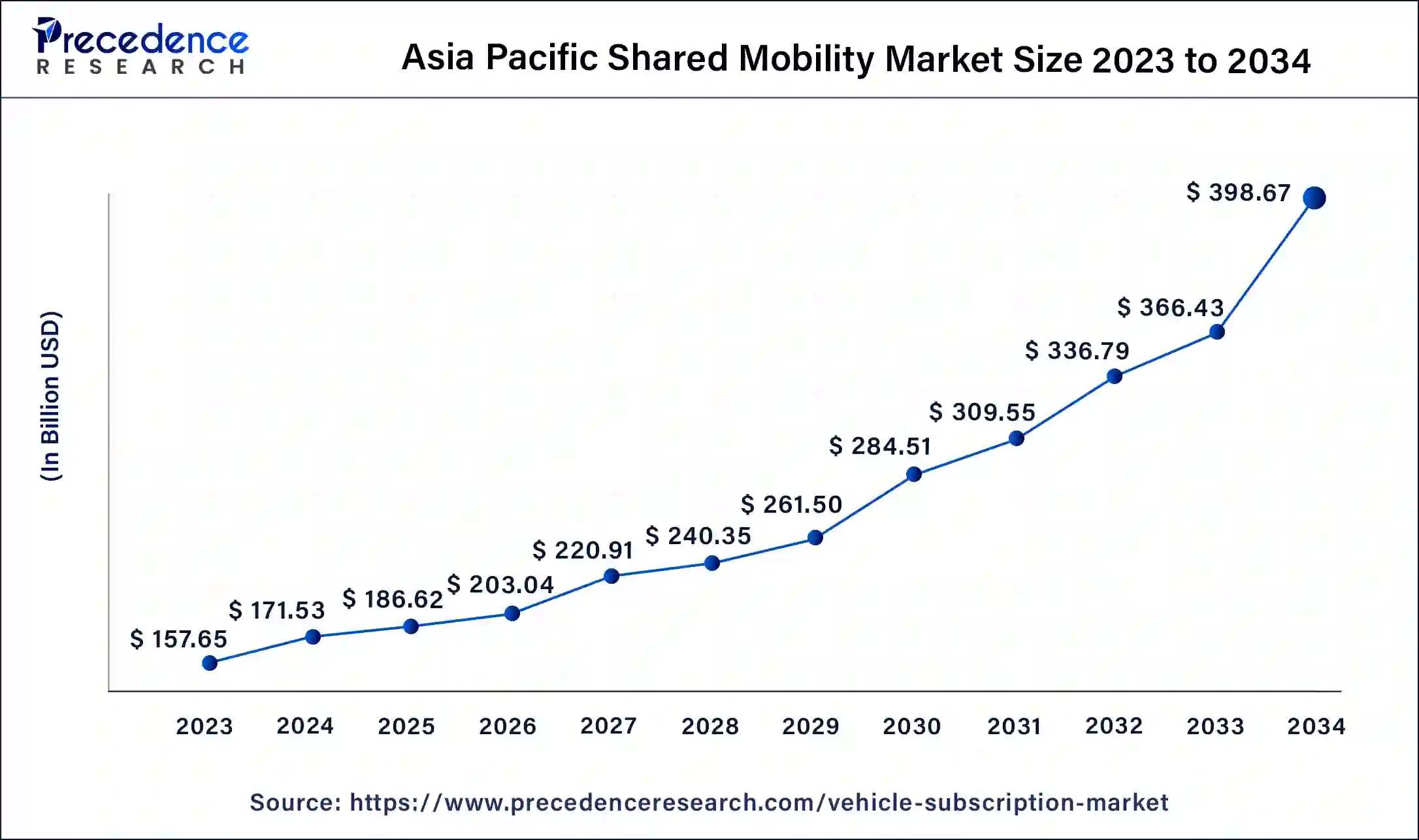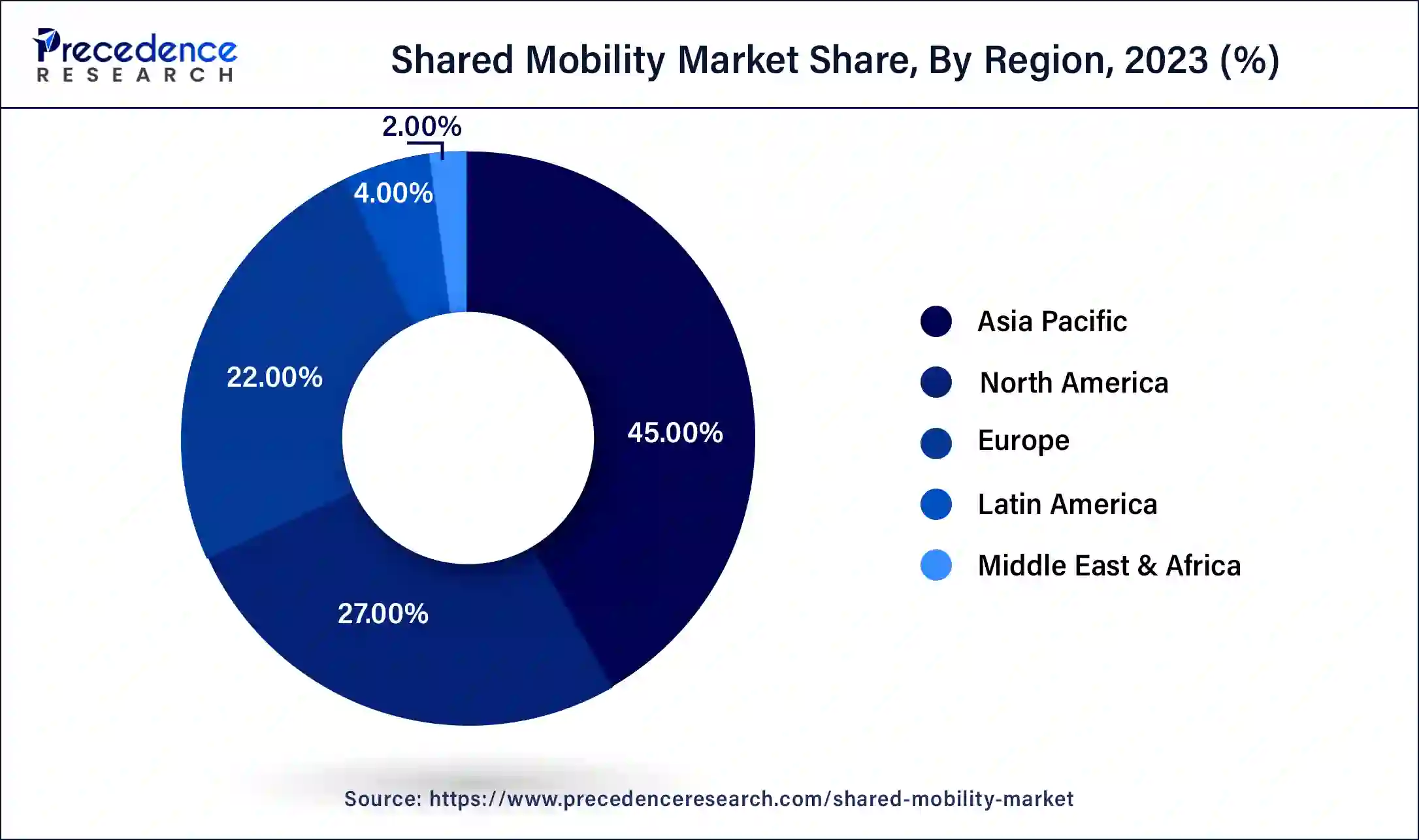List of Contents
What is Shared Mobility Market Size?
The global shared mobility market size accounted for USD 414.71 billion in 2025 and is expected to be worth around USD 953.73 billion by 2035, at a CAGR of 8.68% from 2026 to 2035.The shared mobility market is observed to get accelerated with the rising concerns over environmental issues and the inclination towards sustainable transportation options. Electric scooters, bikes, and shared electric vehicles contribute to eco-friendly alternatives, appealing to environmentally conscious consumers.

Market Highlights
- Asia Pacific led the global market with the highest market share of 45% in 2025.
- By type, the vehicle rental/leasing type segment has held the largest market share of 41% in 2025.
- By vehicle type, the passenger cars segment captured the biggest revenue share of 51% in 2025.
- By business model, the P2P segment registered the maximum market share in 2025.
Technological Advancement
Technological advancements in the shared mobility market feature mobility-as-a-service, blockchain, and AI and machine learning. Mobility-as-a-service (MaaS) is a platform to several transportation modes such as bike sharing, public transit, and ride sharing. It is acquired in a single application, delivering personalization and improving the mobility experience. This platform offers fascinating features such as trip planning and booking services.
Blockchain technology is mainly used in payment systems to secure the money transfer process. It also calculates vehicle usage. AI and machine learning eliminate delay by predicting traffic, and artificial intelligence algorithms optimize routes to benefit ride-sharing services. These technologies are the future for logistics and transportation and a contribution to the shared mobility market.
Shared Mobility Market Growth Factors
The increasing internet penetration and the surge in investment for shared mobility businesses have accelerated the growth of the market. Also, the rising on road traffic congestion, lack of parking spaces, high fuel prices, and high cost of personal vehicle ownership are the key attributes that triggers the growth of the shared mobility market.
The rapid growth of the automobile industry along with the growth of an integrated ecosystem within the transport industry and the Government initiatives in promoting the shared mobility solutions in order to reduce traffic congestion on roads is anticipated to fuel the growth of the shared mobility market. For instance, On 12th October 2021, HERE Technologies, the leading location data and technology platform, announced HERE Probe Data, a new data service delivering useful information on how road users and vehicles move across the transportation network. This service addresses the growing demand from public transport agencies, cities, and companies across the automotive, transport and logistics industries, to better understand road-centric mobility patterns.
In the past decade, there has been a significant rise in pollution due to the use of automobile and therefore in order to reduce the amount of air pollution the Governing agencies across the globe are encouraging the use of shared mobility services and this factor drive the market growth. Also, Shared mobility is economical when compared with personal vehicles as it is less expensive than acquiring and maintaining a vehicle and this accelerates the market growth. For instance, On 7th October 2021, DB Regio AG and ZF Friedrichshafen AG announced that they are collaborating in bringing highly automated and autonomous bus shuttles onto the roads in Germany more quickly.
Market Scope
| Report Highlights | Details |
| Market Size in 2025 | USD 414.71 Billion |
| Market Size in 2026 | USD 451.20 Billion |
| Market Size by 2035 | USD 953.73 Billion |
| Growth Rate from 2026 to 2035 | CAGR of 8.68% |
| Largest Market | Asia Pacific |
| Base Year | 2025 |
| Forecast Period | 2026 to 2035 |
| Segments Covered | Type, Vehicle Type, Business Model, and Region |
| Regions Covered | North America, Asia Pacific, Europe, Latin America, Middle East and Africa |
Segment Insights
Type Insights
The shared mobility market is divided into ride-sharing, vehicle rental/leasing, ride sourcing and private. The vehicle rental/leasing type segment is expected to witness the highest growth accounting for more than 41% of revenue share in 2024 and also it is anticipated to grow at a decent pace during the forecast period owing to increase in population specially in the developing countries.
Furthermore, ride-sharing type segment is also growing significantly during the forecast period owing to the desire of customers opting for more cost-effective and elegant modes of transportation over personal driving preferences. All these factors are estimated to drive the growth of the market. For instance, On 30th September 2021, Europe's leading free-floating car sharing provider SHARE NOW announced that it will use artificial intelligence in overcoming traffic in cities. With the introducing of AI in the car sharing services, Share Now will efficiently manage and control its vehicle fleet.
Vehicle Type Insights
The shared mobility market is divided into Passenger Cars, LCVs, Busses & Coaches and Micro Mobility. The passenger cars in this segment is forecasted to contribute the largest revenue share of more than 51% in 2024 and is estimated to grow remarkably over the forecast period. It is because of the lucrative features provided in the passenger cars and the driving experience it provides. Also, launch of new services by ride-hailing providers is expected to boost the market growth. For instance, On 6th August 2021, Rapido India's largest bike taxi platform announced their expansion of its auto service to Bengaluru, taking the service to a total of 26 cities in India. These services aim to give them access to safer and more affordable commute options and provide other avenues of earning for the auto drivers.
Business Model Insights
The Shared Mobility Market is divided into P2P, B2B and B2C. The P2P business model segment is expected to witness a significant revenue share during the forecast period amounting to more than 55% of the global share. It is also anticipated to grow significantly during the forecast period. It is due to the surge in use of automobiles for rental and leasing services.
Regional Insights
Asia Pacific Shared Mobility Market Size and Growth 2026 to 2035
The Asia Pacific shared mobility market size is exhibited at USD 186.62 billion in 2025 and is predicted to be worth around USD 429.17 billion by 2035, at a CAGR of 8.68% from 2026 to 2035.

Asia Pacific is expected to contribute the largest revenue share of more than 45% in 2024. It is because of the rise in On-road vehicle traffic and costs of vehicle ownership in countries such as China and India. The presence of higher population in these countries of the region is a major factor that drives the growth of Shared Mobility Market in Asia Pacific region. For instance, On 5th October 2021, OLA announced that it has acquired GeoSpoc, a geospatial services provider that will help OLA to bring geospatial technologies to the mass market. Together these two companies will develop technologies which will make mobility universally accessible, sustainable, personalized, and convenient, across shared and personal vehicles.

Asia Pacific is dominating the shared mobility market. The urbanization sector is contributing to the growth of this market in the region. The rising demand for sustainable transportation facilities at an affordable rate is stimulating innovative growth and development.
LAMEA is also expected to grow significantly during the forecast period owing to surge in demand for shared transportation solutions due to increasing number of corporate travelers in this region.
India Shared Mobility Market Trends:
India is seeing a significant growth in the shared mobility market, and the growth is driven by a rapid shift towards urbanization and growing environmental concerns, with increasing pollution due to the use of personal vehicles leading to the increasing demand for shared transportation amid growing environmental conditions and shift towards sustainability which drives the growth for the market in the country. Cost saving and the convenience of shared mobility attract the consumers and fuel the growth.
Technological advancement like the introduction of mobile apps for booking public transport with real-time data with enhancing consumer experience, further increases the adoption of the market. Rising adoption of EVs in the country and sustainable mobility solutions further boost the growth of the market in the country, and also support the expansion of the market in the country.
Latin America Shared Mobility Market Trends:
The growth of the shared mobility market in Latin America is driven by the increasing need for flexible transportation and rising government initiatives for sustainable transportation solutions in the region boost the growth of the market. Government initiatives in the region focusing on eco-friendly solutions and increasing adoption of shared mobility within the population for convenience and cost effectiveness drive the growth of the market.
Flexibility and convenience in shared mobility for users, which also enables them to choose their transportation based on need and preferences of the consumers, drives the growth of the market in the region. Technological advancement like the integration of mobile apps and digital payments for shared mobility services for user-friendly experiences drives the growth of the market in the region and also support the expansion of the shared mobility market.
Shared Mobility Market Companies
- Avis Budget Group
- ANI Technologies Pvt. Ltd. (OLA)
- car2go NA LLC
- Beijing Xiaoju Technology Co, Ltd.
- The Hertz Corporation
- WingzInc.
- Uber Technologies Inc.
- Curb Mobility
- GrabHoldings Inc.
- Lyft Inc.
- Careem Inc.
Recent Developments
- In April 2025, global mobility giant Bolt partnered with one of the world's leading technical universities, ETH Zurich, to create a ‘sustainable urban transitions lab'. The research lab will connect Bolt's frontline data with ETH Zurich's technical expertise to understand urban mobility patterns in European cities and develop scalable blueprints for implementing shared mobility. (Source - https://zagdaily.com)
- In March 2025, Zag turns to B2C. Eindhoven shared its new micromobility operator in town. The Cooltra group recently joined the Collectif mobilite initiative that aims to transform France's mobility sector in the next 25 years. (Source - https://zagdaily.com)
- In April 2025, London-based startup Flock Mobility raised 1 million euros in new funding to accelerate the growth of its AI-driven platform that helps organizations arrange shared electric vehicle (EV) transport. The investment is a huge contribution to the growth of the shared mobility market. (Source - https://tech.eu)
Segments Covered in the Report
By Type
- Ride-sharing
- Vehicle Rental/Leasing
- Ride Sourcing
- Private
By Vehicle Type
- Passenger Cars
- LCVs
- Busses & Coaches
- Micro Mobility
By Business Model
- P2P
- B2B
- B2C
By Vehicle Propulsion
- IC Engine Vehicles
- Gasoline / Petrol
- Diesel
- Electric Vehicles
- Battery Electric Vehicles (BEV)
- Plug-in Hybrid Electric Vehicles (PHEV)
By Sales Channel
- Offline
- Online
By Sector Type
- Unorganized
- Organized
By Region
- North America
- Latin America
- Europe
- Asia-pacific
- Middle and East Africa
For inquiries regarding discounts, bulk purchases, or customization requests, please contact us at sales@precedenceresearch.com
Frequently Asked Questions
Tags
Ask For Sample
No cookie-cutter, only authentic analysis – take the 1st step to become a Precedence Research client



